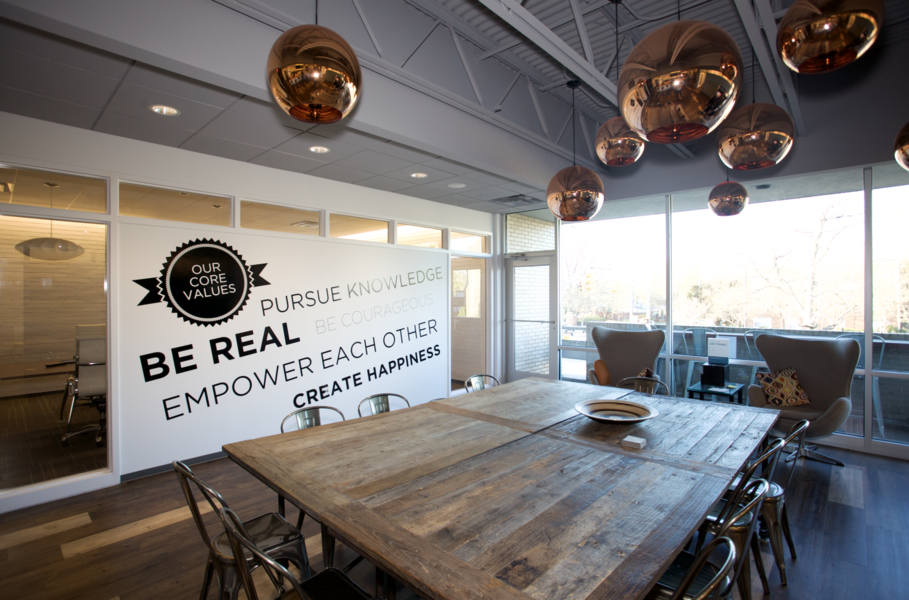
What do you stand for?
It’s a loaded question, but amid an evolving, remote-centric business environment and the ongoing “Great Resignation,” it’s one businesses need to be asking.
When you launch a new business, core values are one of the first items on the agenda. But too often, this process generates a handful of flashy adjectives that are plastered on the careers page, dropped into an onboarding deck and then forgotten. But done correctly, defining and embracing your organization’s core belief system is a crucial step toward becoming a people-first business.
Your organization’s core values aren’t something you claim to be, they’re your DNA. In other words, your values define who you are. At Brooks Bell, we defined and documented these qualities 10 years ago. The executive team gathered at an offsite retreat and hammered out a framework that is unmistakably Brooks Bell:
- Pursue knowledge
- Be real
- Be courageous
- Empower each other
- Create happiness
A decade later, these five values still hang in our office cafe. While I’d like to imagine my design work played a part in our enduring decor, the primary reason is that our values haven’t changed, nor do I believe they should. These are qualities we hold sacred and they inform everything we do, from hiring to firing to pursuing new business. When we say we are a values-driven organization, we mean it.
Having core values as our true north keeps us moving in the right direction, regardless of the unforeseen circumstances that come our way (and the past 18 months have brought their fair share of unforeseen circumstances.) Ensuring values are more than words on a wall requires daily effort. Here are three ways they can inform everyday business practices.
- A Uniting Force
Documenting values is about defining what unites your organization as people, not what generates value for you as a service. They give employees ideas to rally around and pursue in their everyday work, forming a cornerstone of your organization’s culture and community.
But being driven by values doesn’t mean you should only hire people who think and speak the same way. Instead, it means you are bonded by common goals and overarching philosophies that manifest in different ways and adapt to circumstances.
For example, our “create happiness” value isn’t intended to bind employees to a narrow idea of what happiness looks like, or how they should live this value. This concept has translated to creating a fantasy football league, bringing doughnuts to the office, designating open-ended volunteer days and more. Avoiding top-down mandates ensures employees embody our values organically, in a personalized way that still contributes to the whole.
When companies have strong values that inform their work — like Nike partnering with Kapernick or Patagonia donating all Black Friday sales to environmental nonprofits — it makes an impact on team morale. These moves strengthen the commitment of employees who align with your values, making them feel proud to be a part of your organization. Externally, values-driven decisions also gain more buy-in from your supporters. As Nike proved, living your values offers more reward than risk.
These case studies are why I reject the “people over profit” cliche. Of course I believe in a human, people-first approach to business. But I also believe that profit comes from choosing the right people. These two ideas aren’t mutually exclusive, and it’s damaging to believe they must be. When everyone is aligned and driven by the same values, good things happen.
2. A Business Differentiator
Over the years, people have recommended we add core values. Some have suggested new values like “do great work” and “be accountable.” I reject these ideas. These “values” are table stakes in any functioning workplace, not a trait that distinguishes our team. And any times we fall short in these types of areas, we address them as performance issues, not cultural ones. Our values haven’t changed since we established them, and I would argue that well-documented values shouldn’t. Your company’s DNA doesn’t morph when faced with new circumstances, it informs how you respond to those circumstances.

If you find yourself asking how to separate yourself from competitors and other employers, the answer often lies in living your values. Our “pursue knowledge” value has informed everything from our office’s lending library to our “share to learn” Slack channel to our approach to client work. We list this value first on our careers page for a reason: It helps us attract other curious, knowledge-absorbing problem solvers to our team. Our Click community also arose from this value, allowing us to build a network of similarly curious knowledge-pursuing professionals.
As we map out our future, we’ll continue creating opportunities around our values, internally and externally, and hiring team members that share those ideas. But it’s important to note that while you should spend time identifying your core values, you shouldn’t over-engineer them. You set your organization apart not by proclaiming how much you value “transparency” or “support,” but by showing it every day.
3. Directional Guideposts
When you face a murky, difficult business decision, where do you turn? For me, it’s our core values. They don’t make the calls for me, but they serve as a framework that guides decision-making and helps me evaluate hard business problems.
Used properly, values can also be guideposts that inform the way you make difficult decisions. From broad personnel moves to the specific wording on company messages, these qualities can inform your actions at every turn. It doesn’t make decisions easier, but it allows you to have a solid basis for decision-making and a constant true north.
And if your core values are well defined, they’re evergreen — regardless of your company size, market or the state of the world, they hold steady. Recently, Brooks Bell has garnered some unexpected press for two value-driven decisions: company-wide flexible work schedules and giving our team Election Day off. While they generated discussion, they weren’t hard choices or approached differently than other decisions. These policies aligned with our values, made sense for our company and everyone internally agreed.
But for some companies, these “bold” decisions are unimaginable. Some leaders from bigger organizations have pointed out it’s easier for a smaller and nimbler business to take these risks. We may be a small company, but that also means our margins are a lot thinner. Anyone can make these moves, it just requires allowing yourself to think differently.
REI’s “#OptOutside” campaign is a perfect example of this. They leaned into their values, closing stores on Black Friday to encourage exploration over consumerism. They may be missing out on a one-day rush of sales, but they gain it back tenfold in long-term employee satisfaction and customer buy-in. Other companies made a similar investment with “made in the U.S.A” products. Market research and focus-group testing can’t inform these decisions — they come down to knowing who you are, and having the courage to embrace it.
Putting it in Practice
Letting your values lead the way sounds simple. So why do so many companies fall short? In many cases, it’s because leaders confuse profit with values. When employees are worked to the bone and spreadsheets dictate every move to maximize profit, culture goes south. You lose sight of what drives you, and become just another company with a revolving door of unfulfilled employees.
No business will regret becoming a values-driven organization. When you actually put your core values into practice, it drives more innovation, alignment and retention. By defining who you are and standing up for this core belief system, you give your team a reason to jump on board and invest in your company’s future.
As more companies look to hire in a competitive job market, it’s worth examining how your company’s core values can inform your path forward. The best way to ensure you remain on a steady, positive trajectory is to use these values as a guiding light, focusing on adding team members and making business moves that align with your company’s foundational beliefs.
Our business partners, job candidates and customers are wondering what we stand for. As business leaders, we can’t just tell them. We have to prove it.
